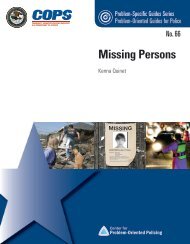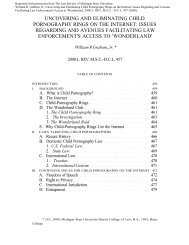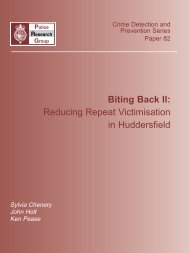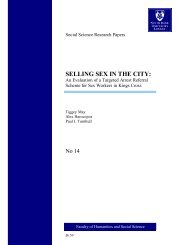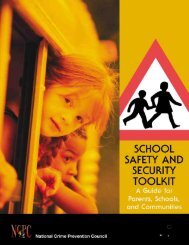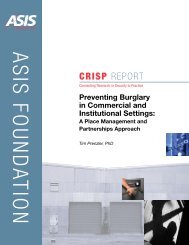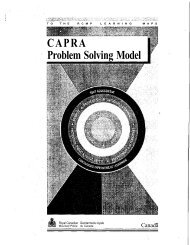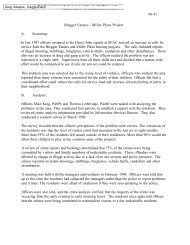Child Pornography: - Center for Problem-Oriented Policing
Child Pornography: - Center for Problem-Oriented Policing
Child Pornography: - Center for Problem-Oriented Policing
You also want an ePaper? Increase the reach of your titles
YUMPU automatically turns print PDFs into web optimized ePapers that Google loves.
Another area of legislative action related to child sexual exploitation has been the<br />
transmission of material that is harmful to minors. While not specifically focused on child<br />
pornography the Communications Decency Act of 1996 211 (CDA) prohibited the knowing<br />
transmission of "obscene or indecent" messages via a telecommunications device to a minor.<br />
It also prohibited the knowing use of an interactive computer service to send any communications<br />
that depict or describe in "patently-offensive" terms, as measured by contemporary<br />
community standards, sexual or excretory activities or organs to a specific minor. 212 The CDA<br />
was challenged in Reno v. American Civil Liberties Union. 213 In that case the Supreme Court<br />
ruled that notwithstanding the importance of the government's goal of protecting children<br />
from harmful materials on the Internet, the CDA's "indecent-transmission" and "patently-offensive-display"<br />
provisions violated the First Amendment's right to free speech. 214<br />
The Court, however, expressly preserved the government's right to pursue related obscenity<br />
or child-pornography charges. 215<br />
To remedy the constitutional deficiencies of the CDA, Congress passed the <strong>Child</strong> Online<br />
Protection Act of 1998 (COPA). 216 COPA requires those who commercially distribute materials<br />
through the world wide web to restrict access by children younger than 17 to materials<br />
that are harmful to minors. 217 COPA has been challenged as presumptively invalid and subject<br />
to strict scrutiny analysis under the First Amendment as a content-based regulation of<br />
nonobscene sexual expression. 218 The court hearing that challenge has issued a preliminary<br />
injunction against en<strong>for</strong>cement of COPA until the case has been decided on its merits. 219<br />
The <strong>Child</strong>ren's Internet Protection Act, which became law in December 2000, 220 is a<br />
further development in the protection of children from harmful materials on the Internet. This<br />
Act limits the availability of certain federal funds and service discounts <strong>for</strong> schools unless<br />
they implement a policy of Internet safety <strong>for</strong> children that uses technology-protection measures<br />
such as filters to block access to visual depictions that are obscene, child pornography,<br />
or harmful to minors. 221 They must also have a policy <strong>for</strong> other (i.e., adult) users prohibiting<br />
access to visual depictions that are obscene or child pornography. 222 The Act contains similar<br />
limitations on funds <strong>for</strong> libraries.<br />
In addition neighborhood schools and libraries that receive service discounts from telecommunications<br />
carriers must have an Internet safety policy that addresses access by children<br />
to inappropriate material on the Internet and world wide web; the safety and security of children<br />
when using E-mail, chat rooms, or other direct electronic communication; unlawful<br />
activities by minors online including unauthorized access such as hacking; unauthorized<br />
disclosure, use, or dissemination of personal, identifying in<strong>for</strong>mation about children; and<br />
measures designed to restrict children's access to materials harmful to minors. 223<br />
Based on this evolution of federal child-pornography legislation and the case law interpreting<br />
its provisions, the section below describes federal criminal-child-pornography statutes<br />
as they currently exist.<br />
Federal <strong>Child</strong> <strong>Pornography</strong> Statutes<br />
The federal statutes that address criminal child sexual exploitation and child pornography fall<br />
under Title 18, Sections 2251 through 2260 of the United States Code.<br />
The definitions applying to federal child-pornography charges are found in Section 2256.<br />
Most important to the interpretation of the federal statutes, as evidenced by the court challenges<br />
discussed above, are the definitions of<br />
18 - CHILD PORNOGRAPHY: THE CRIMINAL-JUSTICE-SYSTEM RESPONSE




